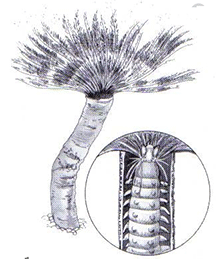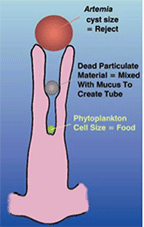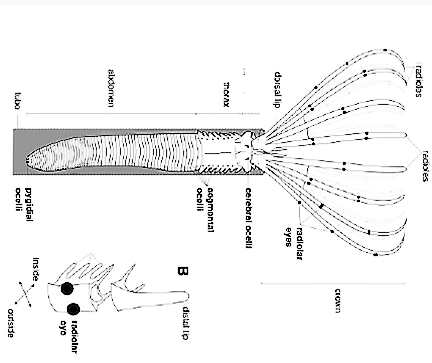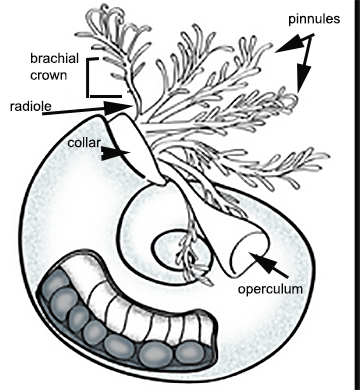Circulation:
Probably one of the key characteristics of the group is that most posses a well developed closed circulatory system.
Students are able to see and document closed circulation in a small simple freshwater oligochaete and a polychaete that can reach several inchees in size.
Lumbriculus, or blackworms, are a common fresh water annelid showing the typical characteristics of a oligochaete. These annelids are common in ponds and marches clinging to substrate or each other in a glass petri dish.
An individual worm can be placed in a capillary tube so its circulation can be examined under the microscope. The film below shows a side view, the dorsal vessal is visible as is the lateral vessel that will connects to the unseen ventral vessel in this simple but closed circulatory system.
The fire or bristle worm is a polychaete, and its name comes from its habit of shedding the paired set of "bristles" (modified sensory hairs) found on each segment. They can penetrate the skin and cause a burning sensation on contact.
Circulation in this larger worms involves more lateral vessels that extend to the parapodia and eventually connect to a main dorsal and ventral vessel.
Oligochaetes are relatively unmodified from the classic model or the earthworm, but size can make a difference in how easily common annelid characteristics are observed.
Aeolosoma is a small microscopic oligochaete. Examine the film below to see some of the external structural modification that can accompany small size in this group.
Polychaetes are more diverse in structure and diet.
Glycera is a marine bloodworm and an active predator as the fireworm already examined. https://www.nhm.ac.uk/discover/news/2014/september/fishing-bait-bloodworms-have-bee-sting-bites.html
It is using its head and protruded jaws to try to burrow in the film below. Those jaws not visible in the film when fully extended can exert a quick and painful bite. While not deadly to humans it can produce in some an allergic reaction.
---
Possibly the most attractive of the polychaetes are the spagetti worms. Amphitrite worms are large worms that are considered because of the coloring of their "gills" some of the most attractive. In the film below, two individuals in burrows extend their tentacle to search for food. The accessory gills are bright red due to the presence of haemoblobin. Gas exchange in these occurs at the surface and then any oxygen collected can be moved to parts of the worm deep in the burrow. They usually live in U shaped burrows in mud substrates. One of the specimens, filmed outside its burrow, shows a segmented body that is divided into three regions, a head, thorax, and abdomen. The head is specialized for feeding and respiration, the thorax for moving in the tube, and the abdomen for the digestion of food.
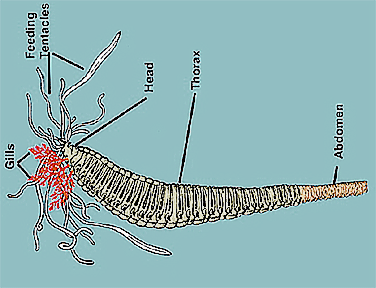
A closer view of the gills. Not all polychaetes have accessory respiratory structures or gills and gas exchange is accomplished simply through skin.
Tube dwellers such as Amphitrite spp. are found everywhere in the marine environment. The film below examines feeding in a small tube dweller with two tentacles, or feeding filaments. found amid sediment that collects between individuals in a barnacle colony. it clearly shows the role of the tentacles in feeding and the worm's head and some of its body is visible by the end of the film. This small tube dweller has a much more uniform body. Each segment looks much like the next, and while a head is present, the remainder of the worm’s body is probably not divided into sections.
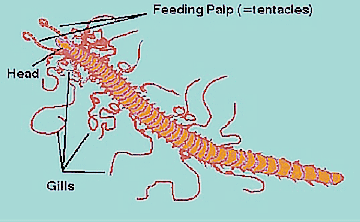
Fan worms are very discriminating feeders. Food moves down a tract that eventually rejects some items and accepts others. Below are films of a large sabillid that lives in our aquaria. You can see the outline of groves on the radioles or individual branches that constitute the branchial crown or circle of "feathers" that direct food traffic toward or away from the mouth. Unfortunately in this film only rejection of improper sized particles is observed. Look to your lower left at the beginning of the close up view of radioles (starts at about 45 sec). Follow the progress of the while particles which first get moved toward feathers than away with mucous attached to them. There is a close up of the tracks in the radioles at the end of the film.
Films of a smaller worm follow, in which one can observe proper sized particles moving down the radioles at end of film.
